Abstract
Cloned lines of Babesia bovis were prepared from the avirulent vaccine strain, Ka, by an in vivo limiting dilution procedure. The virulence of these clones for adult Bos taurus cattle varied from completely avirulent to highly virulent. This suggests that the parent strain, Ka, is composed of a mixture of subpopulations of varied virulence. Passage of the avirulent clone K-19-47 in intact (nonsplenectomized) cattle resulted in its full reversion to virulence. This suggests that two mechanisms are operating to enable virulence to be a readily modified characteristic in this parasite: differential gene expression and phenotypic selection of subpopulations. A series of experiments demonstrated that all clones were non-tick transmissible. This lack of vector transmission was a stable characteristic and could not be altered by the passage of K-19-47 in intact cattle, despite the fact that passage in intact animals caused this clone to revert to the fully virulent phenotype. A mechanism is suggested for the virulence and vector transmission variations observed in B. bovis.
Full text
PDF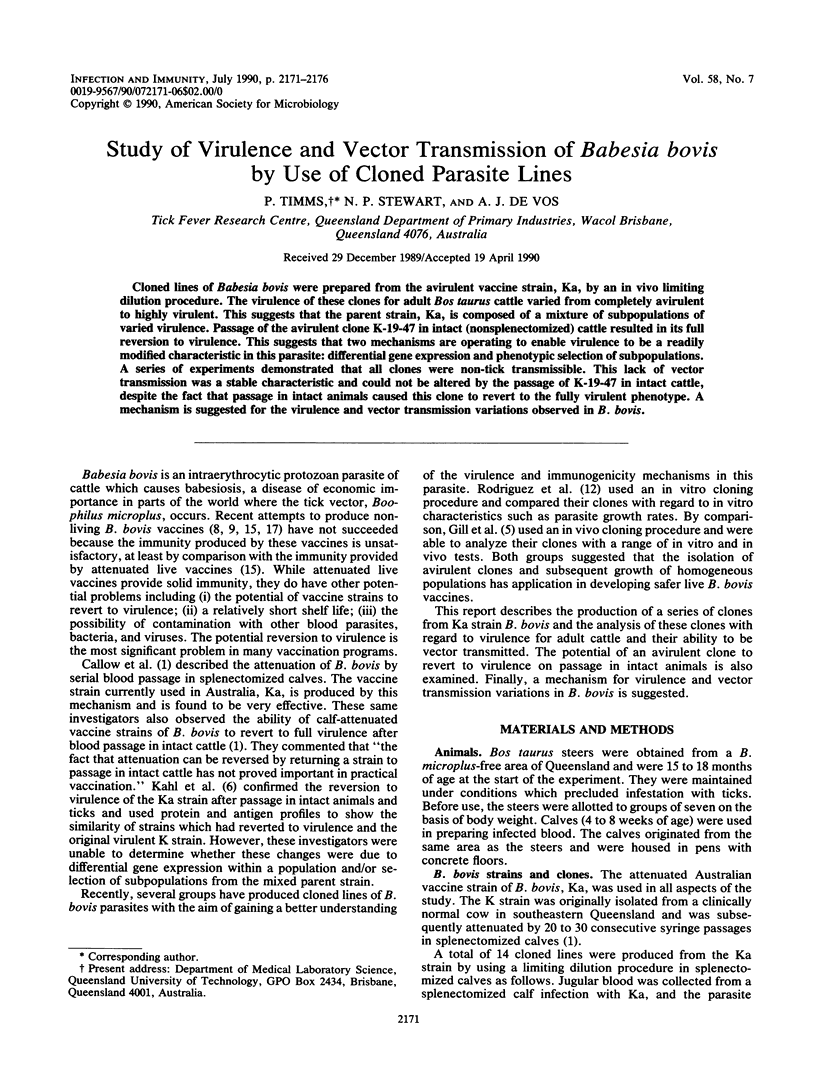
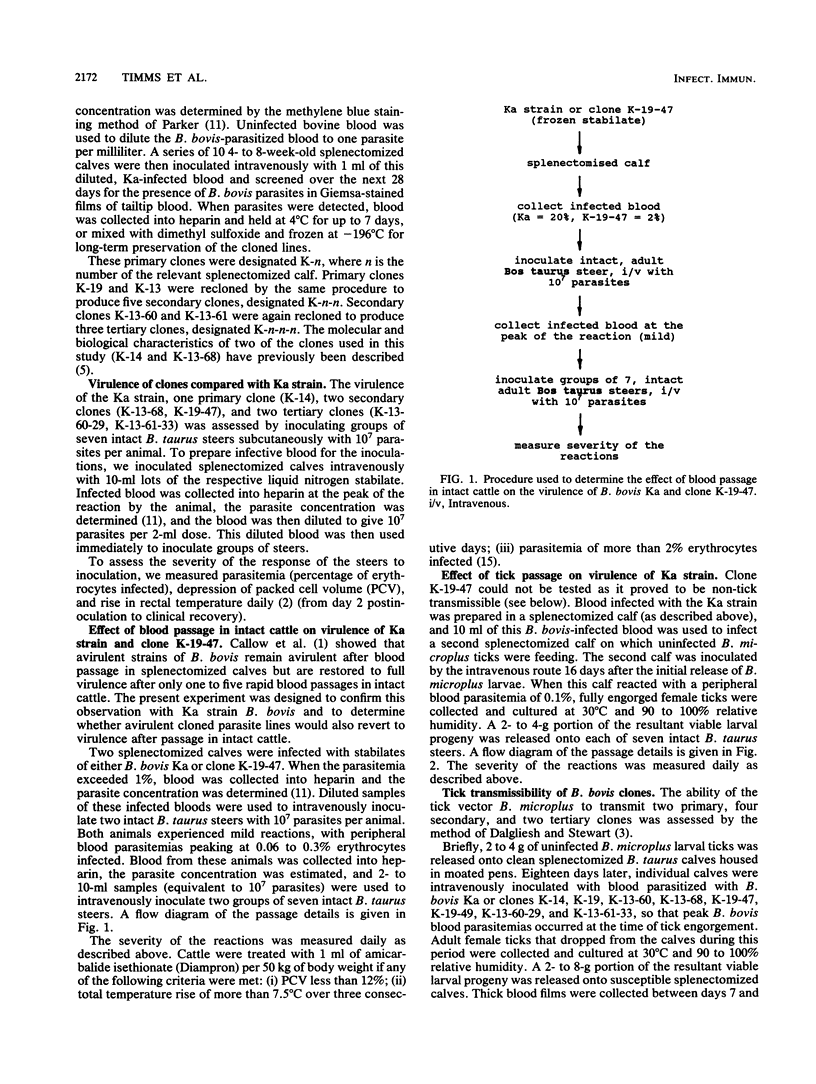
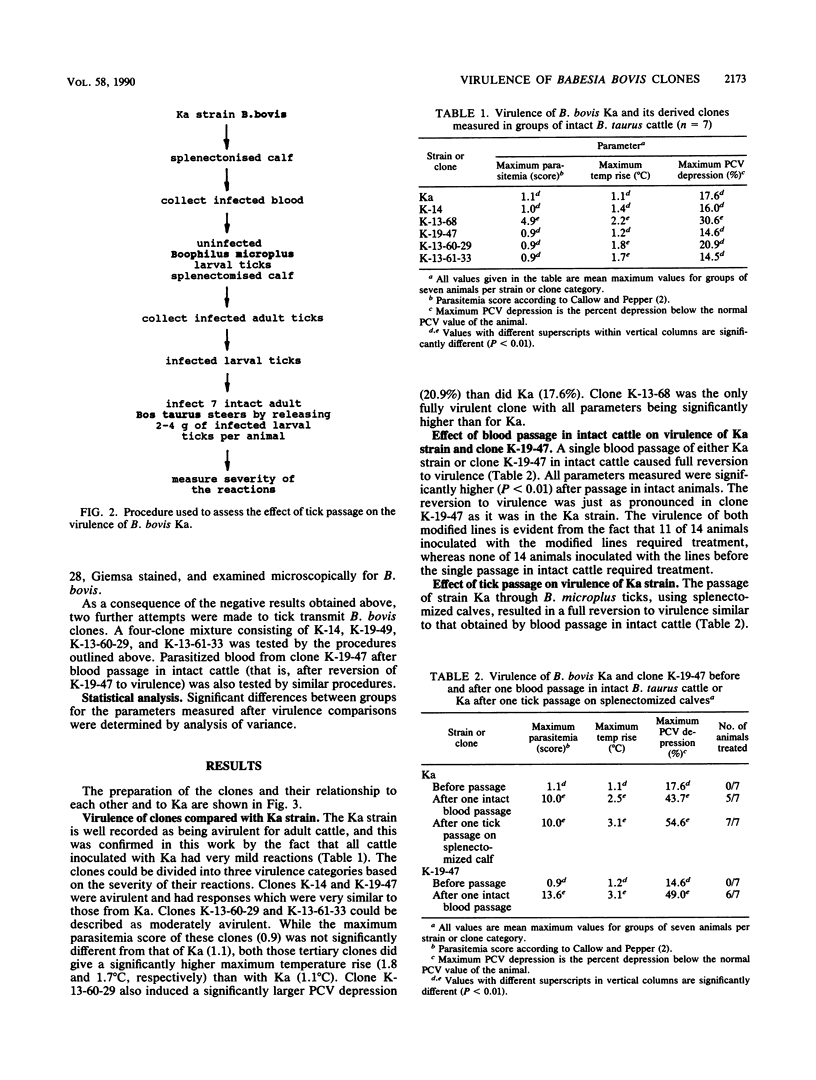
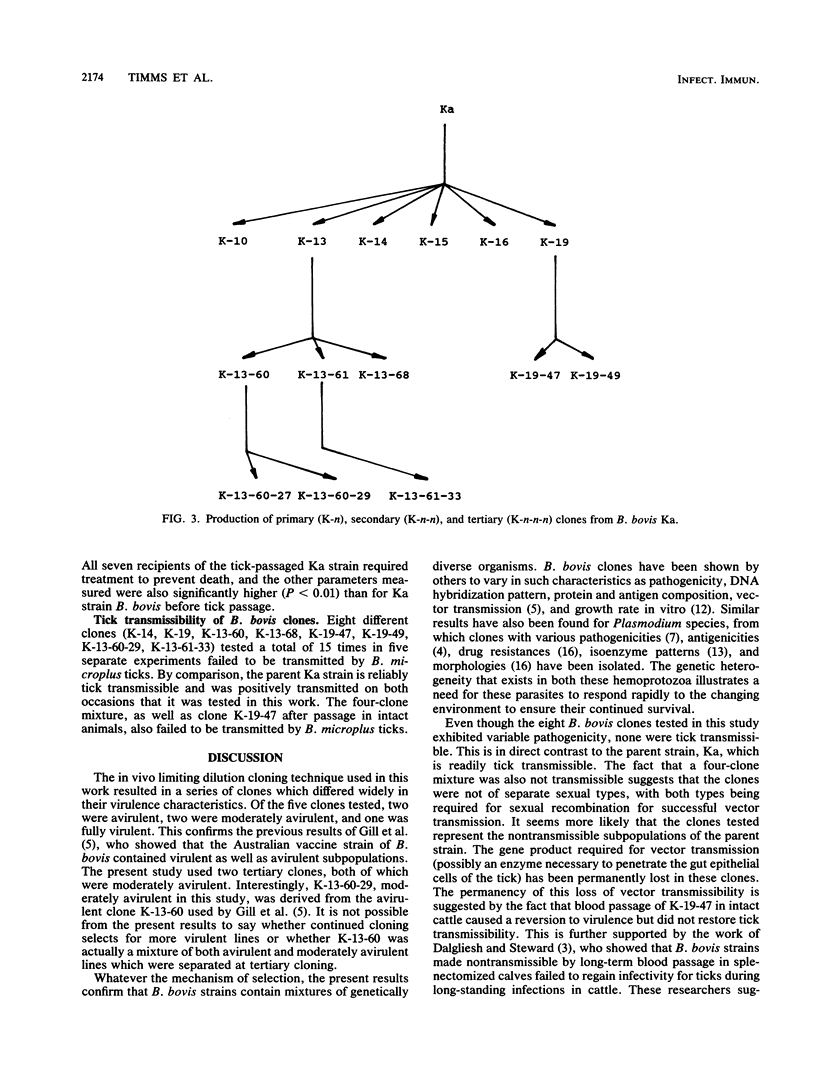
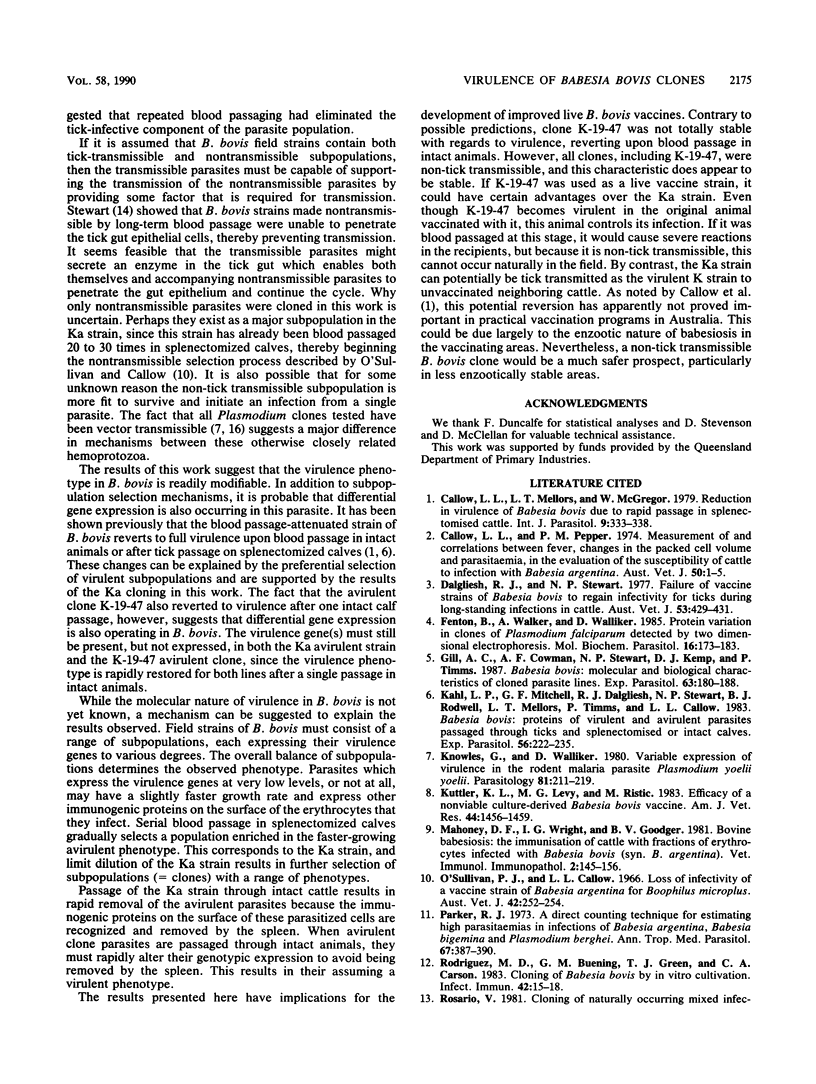
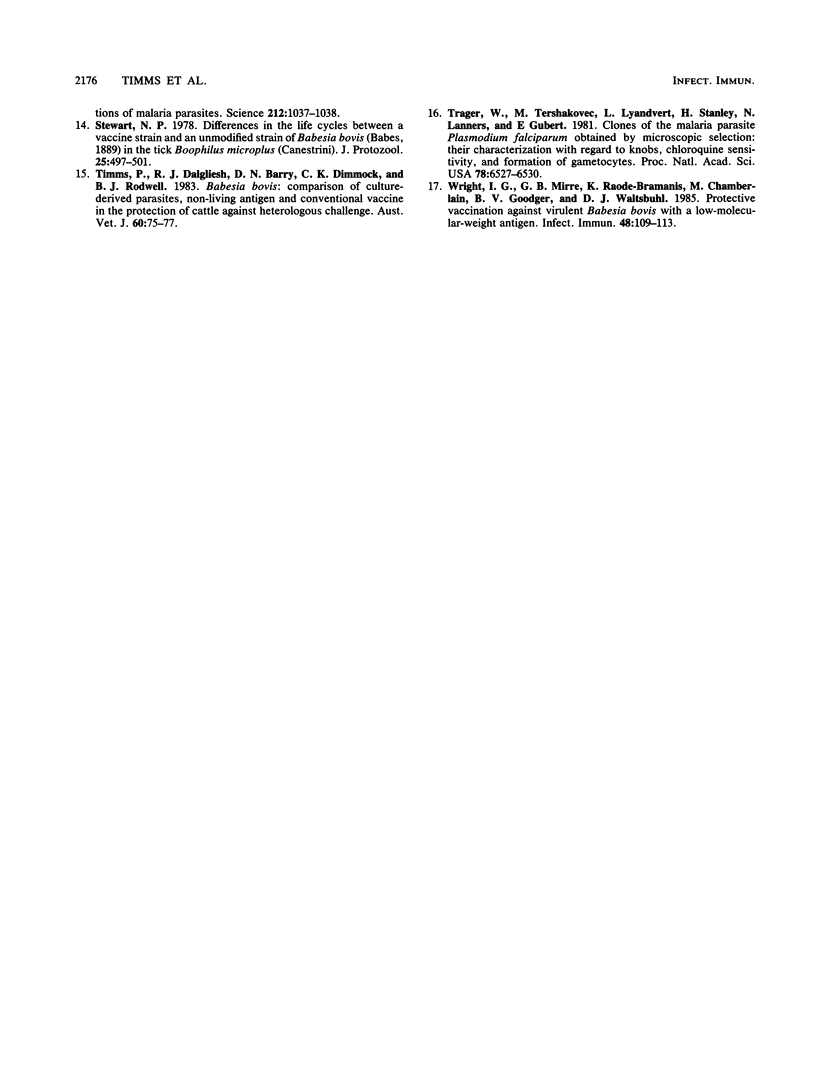
Selected References
These references are in PubMed. This may not be the complete list of references from this article.
- Callow L. L., Mellors L. T., McGregor W. Reduction in virulence of Babesia bovis due to rapid passage in splenectomized cattle. Int J Parasitol. 1979 Aug;9(4):333–338. doi: 10.1016/0020-7519(79)90083-3. [DOI] [PubMed] [Google Scholar]
- Callow L. L., Pepper P. M. Measurement of and correlations between fever, changes in the packed cell volume and parasitaemia in the evaluation of the susceptibility of cattle to infection with Babesia argentina. Aust Vet J. 1974 Jan;50(1):1–5. doi: 10.1111/j.1751-0813.1974.tb09358.x. [DOI] [PubMed] [Google Scholar]
- Dalgliesh R. J., Stewart N. P. Failure of vaccine strains of Babesia bovis to regain infectivity for ticks during long-standing infections in cattle. Aust Vet J. 1977 Sep;53(9):429–431. doi: 10.1111/j.1751-0813.1977.tb05491.x. [DOI] [PubMed] [Google Scholar]
- Fenton B., Walker A., Walliker D. Protein variation in clones of Plasmodium falciparum detected by two dimensional electrophoresis. Mol Biochem Parasitol. 1985 Aug;16(2):173–183. doi: 10.1016/0166-6851(85)90085-4. [DOI] [PubMed] [Google Scholar]
- Gill A. C., Cowman A. F., Stewart N. P., Kemp D. J., Timms P. Babesia bovis: molecular and biological characteristics of cloned parasite lines. Exp Parasitol. 1987 Apr;63(2):180–188. doi: 10.1016/0014-4894(87)90160-3. [DOI] [PubMed] [Google Scholar]
- Kahl L. P., Mitchell G. F., Dalgliesh R. J., Stewart N. P., Rodwell B. J., Mellors L. T., Timms P., Callow L. L. Babesia bovis: proteins of virulent and avirulent parasites passaged through ticks and splenectomized or intact calves. Exp Parasitol. 1983 Oct;56(2):222–235. doi: 10.1016/0014-4894(83)90066-8. [DOI] [PubMed] [Google Scholar]
- Knowles G., Walliker D. Variable expression of virulence in the rodent malaria parasite Plasmodium yoelii yoelii. Parasitology. 1980 Aug;81(1):211–219. doi: 10.1017/s0031182000055165. [DOI] [PubMed] [Google Scholar]
- Kuttler K. L., Levy M. G., Ristic M. Cell culture-derived Babesia bovis vaccine: sequential challenge exposure of protective immunity during a 6-month postvaccination period. Am J Vet Res. 1983 Aug;44(8):1456–1459. [PubMed] [Google Scholar]
- Mahoney D. F., Wright I. G., Goodger B. V. Bovine babesiosis: the immunization of cattle with fractions of erythrocytes infected with Babesia bovis (syn B. argentina). Vet Immunol Immunopathol. 1981 Apr;2(2):145–156. doi: 10.1016/0165-2427(81)90046-5. [DOI] [PubMed] [Google Scholar]
- O'Sullivan P. J., Callow L. L. Loss of infectivity of a vaccine strain of Babesia argentina for Boophilus microplus. Aust Vet J. 1966 Jul;42(7):252–254. doi: 10.1111/j.1751-0813.1966.tb04715.x. [DOI] [PubMed] [Google Scholar]
- Parker R. A direct counting technique for estimating high parasitaemias in infections of Babesia argentina, Babesia bigemina and Plasmodium berghei. Ann Trop Med Parasitol. 1973 Dec;67(4):387–390. doi: 10.1080/00034983.1973.11686904. [DOI] [PubMed] [Google Scholar]
- Rodriguez S. D., Buening G. M., Green T. J., Carson C. A. Cloning of Babesia bovis by in vitro cultivation. Infect Immun. 1983 Oct;42(1):15–18. doi: 10.1128/iai.42.1.15-18.1983. [DOI] [PMC free article] [PubMed] [Google Scholar]
- Stewart N. P. Differences in the life cycles between a vaccine strain and an unmodified strain of Babesia bovis (Babes, 1889) in the tick Boophilus microplus (Canestrini). J Protozool. 1978 Nov;25(4):497–501. doi: 10.1111/j.1550-7408.1978.tb04175.x. [DOI] [PubMed] [Google Scholar]
- Timms P., Dalgliesh R. J., Barry D. N., Dimmock C. K., Rodwell B. J. Babesia bovis: comparison of culture-derived parasites, non-living antigen and conventional vaccine in the protection of cattle against heterologous challenge. Aust Vet J. 1983 Mar;60(3):75–77. doi: 10.1111/j.1751-0813.1983.tb05874.x. [DOI] [PubMed] [Google Scholar]
- Trager W., Tershakovec M., Lyandvert L., Stanley H., Lanners N., Gubert E. Clones of the malaria parasite Plasmodium falciparum obtained by microscopic selection: their characterization with regard to knobs, chloroquine sensitivity, and formation of gametocytes. Proc Natl Acad Sci U S A. 1981 Oct;78(10):6527–6530. doi: 10.1073/pnas.78.10.6527. [DOI] [PMC free article] [PubMed] [Google Scholar]
- Wright I. G., Mirre G. B., Rode-Bramanis K., Chamberlain M., Goodger B. V., Waltisbuhl D. J. Protective vaccination against virulent Babesia bovis with a low-molecular-weight antigen. Infect Immun. 1985 Apr;48(1):109–113. doi: 10.1128/iai.48.1.109-113.1985. [DOI] [PMC free article] [PubMed] [Google Scholar]


